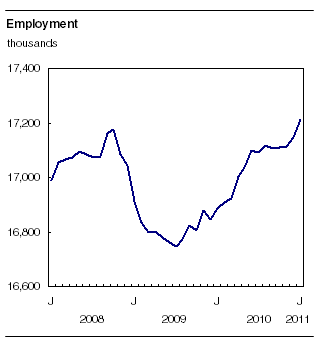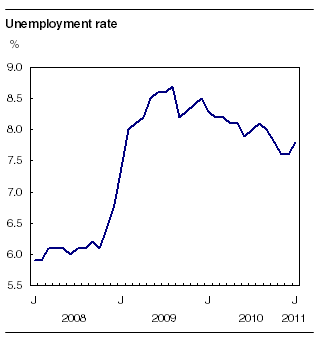Labour Force Survey
Archived Content
Information identified as archived is provided for reference, research or recordkeeping purposes. It is not subject to the Government of Canada Web Standards and has not been altered or updated since it was archived. Please "contact us" to request a format other than those available.
Related subjects
-
[an error occurred while processing this directive]
Employment rose for the second consecutive month in January, with a gain of 69,000. At the same time, the unemployment rate increased by 0.2 percentage points to 7.8%, as more people searched for work. Compared with January 2010, employment was up 1.9% (+327,000).

January's employment increase was evenly split between full and part time. Compared with the same month a year earlier, part-time employment grew by 2.8% (+91,000), while full time increased by 1.7% (+236,000).
Increases in employment in January occurred in business, building and other support services; public administration; and agriculture. Transportation and warehousing as well as accommodation and food services posted declines.
Employment gains in January were spread across six provinces: Ontario, Alberta, Nova Scotia, Newfoundland and Labrador, Manitoba and Prince Edward Island.
Note to readers
A standard revision has been applied to Labour Force Survey (LFS) estimates, as announced in The Dailyon January 28, 2011. Beginning with this release, historical comparisons of estimates produced by the LFS must be made with revised historical data.
All estimates have been adjusted to reflect the 2006 Census population data. Industry estimates have been reclassified from the 2002 to the 2007 North American Industry Classification System (NAICS). Occupation estimates have been reclassified from the 2001 to the 2006 National Occupational Classification: Statistics (NOC-S). Geography boundaries have been updated from the 2001 to the 2006 Standard Geographical Classification (SGC), which mainly affects boundaries of census metropolitan areas and census agglomerations. There was also an update of seasonal adjustment. For an overview of the effect of these changes on the estimates, see "The 2011 revisions of the Labour Force Survey", which is available as part of the Improvements to the Labour Force Survey series (71F0031X, free).
Revised historical data are available on CANSIM. To facilitate access to these revised estimates, LFS data on CANSIM will be free of charge until February 11.
LFS estimates are based on a sample, and are therefore subject to sampling variability. Estimates for smaller geographic areas or industries will have more variability. For an explanation of sampling variability of estimates, and how to use standard errors to assess this variability, consult the "Data quality" section of the publication Labour Force Information (71-001-X, free).
Unless otherwise stated, this release presents seasonally adjusted data, which facilitates comparisons by removing the effects of seasonal variations.
In January, employment gains were shared among private sector employees, public sector employees and the self-employed. Over the past 12 months, there was growth among employees in both the public sector (+3.4%) and private sector (+2.5%), while self-employment declined by 2.3%.
The bulk of the employment gains in January were among women aged 25 and over.
Starting with this release, historical comparisons are based on revised estimates (see Note to readers).

Most of the employment increases in the service sector
Following losses in December, business, building and other support services had notable gains in January (+34,000). There were also gains in public administration (+20,000) and agriculture (+13,000).
Manufacturing employment was little changed in January, following a sizeable increase of 66,000 the previous month. Employment in this industry was up 3.3% (+57,000) from January 2010.
Following notable gains in December, transportation and warehousing employment declined by 32,000 in January. Nonetheless, employment in this industry remained 6.5% (+51,000) higher than 12 months earlier.
Employment in accommodation and food services fell by 26,000 in January, bringing total losses to 3.5% (-37,000) over the past 12 months.
Employment gains spread across several provinces
In Ontario, employment increased for the third consecutive month, up 36,000 in January. The unemployment rate held steady at 8.1%, as there were more people participating in the labour market. With January's increase, the number of workers in Ontario grew by 2.3% (+151,000) from the same month a year earlier, above the national growth rate of 1.9%.
Alberta posted a notable employment increase of 22,000 in January, bringing total growth over the past 12 months to 44,000 (+2.2%). However, the unemployment rate rose by 0.4 percentage points to 5.9% in January as a result of an increase in the number of people seeking work.
Employment rose by 6,200 in Nova Scotia in January, pushing the unemployment rate down 0.9 percentage points to 9.5%.
In Newfoundland and Labrador, employment increased for the second month in a row, up 4,900 in January. This increase brings total gains in the province to 5.6% (+12,000) compared with a year earlier, the fastest rate of growth in the country.
Employment rose by 4,100 in Manitoba in January, bringing total employment gains over the previous 12 months to 10,000 (+1.6%).
In British Columbia, employment edged down in January and the unemployment rate increased 0.6 percentage points to 8.2%. Compared with a year earlier, employment was up 0.7% (+15,000).
Employment in Quebec was unchanged in January, and the unemployment rate rose to 7.9%, as more people searched for work. Over the past 12 months, Quebec's employment increased by 2.3% (+88,000).
More women employed in January
Employment among women aged 25 and over increased in January (+55,000), with gains for both the 25 to 54 and 55 and over age groups.
Over the past 12 months, however, employment growth for women was concentrated among those aged 55 and over. Their rate of employment (the proportion of women employed) rose by 1.4 percentage points to 29.4%. Over the same period, the rate of employment for women aged 25 to 54 declined 0.5 percentage points to 77.0%.
In January, employment was little changed for men aged 25 and over. Over the past 12 months, the rate of employment increased by 1.5 percentage points to 84.6% for men aged 25 to 54, while it increased by 1.0 percentage point to 39.5% for men aged 55 and over.
The number of 15- to 24- year-olds employed was little changed in January and their unemployment rate increased by 0.6 percentage points to 14.4%, as more youths searched for work. Compared with 12 months earlier, employment and the rate of employment for youth were virtually unchanged.
Available on CANSIM: tables 282-0001 to 282-0042, 282-0047 to 282-0063 and 282-0069 to 282-0121.
Definitions, data sources and methods: survey number 3701.
A more detailed summary, Labour Force Information (71-001-X, free), is now available for the week ending January 15. From the Key resource module of our website under Publications, choose All subjects, then Labour.
Data tables are also now available online. From the Subject module of our website, choose Labour.
The next release of the Labour Force Survey will be on March 11.
For general information or to order data, contact Client Services (toll-free 1-866-873-8788; 613-951-4090; labour@statcan.gc.ca). To enquire about the concepts, methods or data quality of this release, contact Lahouaria Yssaad (613-951-0627; lahouaria.yssaad@statcan.gc.ca) or Jeannine Usalcas (613-951-4720; jeannine.usalcas@statcan.gc.ca), Labour Statistics Division.
- Date modified:
